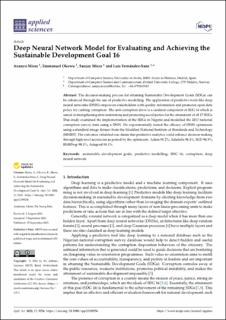| dc.contributor.author | Misra, Ananya | |
| dc.contributor.author | Okewu, Emmanuel | |
| dc.contributor.author | Misra, Sanjay | |
| dc.contributor.author | Fernández-Sanz, Luis | |
| dc.date.accessioned | 2022-10-26T11:54:02Z | |
| dc.date.available | 2022-10-26T11:54:02Z | |
| dc.date.created | 2022-09-16T09:26:42Z | |
| dc.date.issued | 2022 | |
| dc.identifier.citation | Applied Sciences. 2022, 12 (18), Artikkel 9256. | en_US |
| dc.identifier.issn | 2076-3417 | |
| dc.identifier.uri | https://hdl.handle.net/11250/3028428 | |
| dc.description.abstract | The decision-making process for attaining Sustainable Development Goals (SDGs) can be enhanced through the use of predictive modelling. The application of predictive tools like deep neural networks (DNN) empowers stakeholders with quality information and promotes open data policy for curbing corruption. The anti-corruption drive is a cardinal component of SDG 16 which is aimed at strengthening state institutions and promoting social justice for the attainment of all 17 SDGs. This study examined the implementation of the SDGs in Nigeria and modelled the 2017 national corruption survey data using a DNN. We experimentally tested the efficacy of DNN optimizers using a standard image dataset from the Modified National Institute of Standards and Technology (MNIST). The outcomes validated our claims that predictive analytics could enhance decision-making through high-level accuracies as posted by the optimizers: Adam 98.2%; Adadelta 98.4%; SGD 94.9%; RMSProp 98.1%; Adagrad 98.1%. | en_US |
| dc.language.iso | eng | en_US |
| dc.publisher | MDPI | en_US |
| dc.rights | Navngivelse 4.0 Internasjonal | * |
| dc.rights.uri | http://creativecommons.org/licenses/by/4.0/deed.no | * |
| dc.subject | sustainable development goals | en_US |
| dc.subject | predictive modelling | en_US |
| dc.subject | SDG 16 | en_US |
| dc.subject | corruption | en_US |
| dc.subject | deep neural network | en_US |
| dc.title | Deep Neural Network Model for Evaluating and Achieving the Sustainable Development Goal 16 | en_US |
| dc.type | Peer reviewed | en_US |
| dc.type | Journal article | en_US |
| dc.description.version | publishedVersion | en_US |
| dc.rights.holder | © 2022 by the authors. | en_US |
| dc.source.volume | 12 | en_US |
| dc.source.journal | Applied Sciences | en_US |
| dc.source.issue | 18 | en_US |
| dc.identifier.doi | 10.3390/app12189256 | |
| dc.identifier.cristin | 2052312 | |
| dc.source.articlenumber | 9256 | en_US |
| cristin.ispublished | true | |
| cristin.fulltext | original | |
| cristin.qualitycode | 1 | |

